Photo / Video Gallery
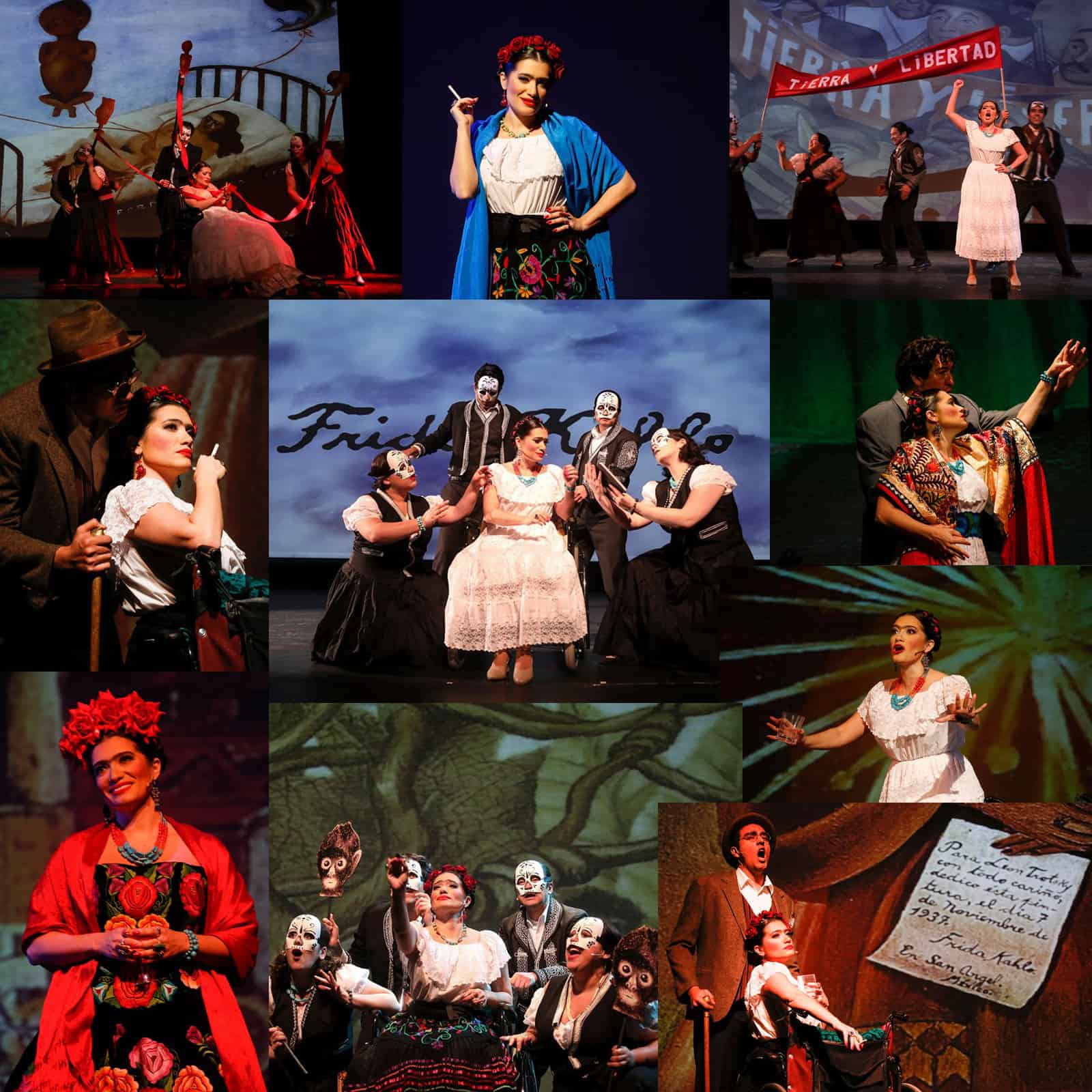
Community Connections
“Our repertoire choices are always made with our community interests and needs in mind,” said Reed Smith, General Director. “In addition to the significant Hispanic community in Anchorage, Frida afforded us the new opportunity to work closely and integrate with our strong visual and fine arts community on ancillary projects beneficial to our community, while also reaching many other segments as well. Frida Kahlo’s status as an icon of our LGBTQ community opened a dialogue with them, and her triumph, despite disability, provided connections to the disabled and organizations that serve them. As she was a polio survivor, producing the opera interested the 15 area Rotary International Clubs in the area.”
Family Opera Day at the Museum – Saturday, Jan 25 (11 am – 3 pm)
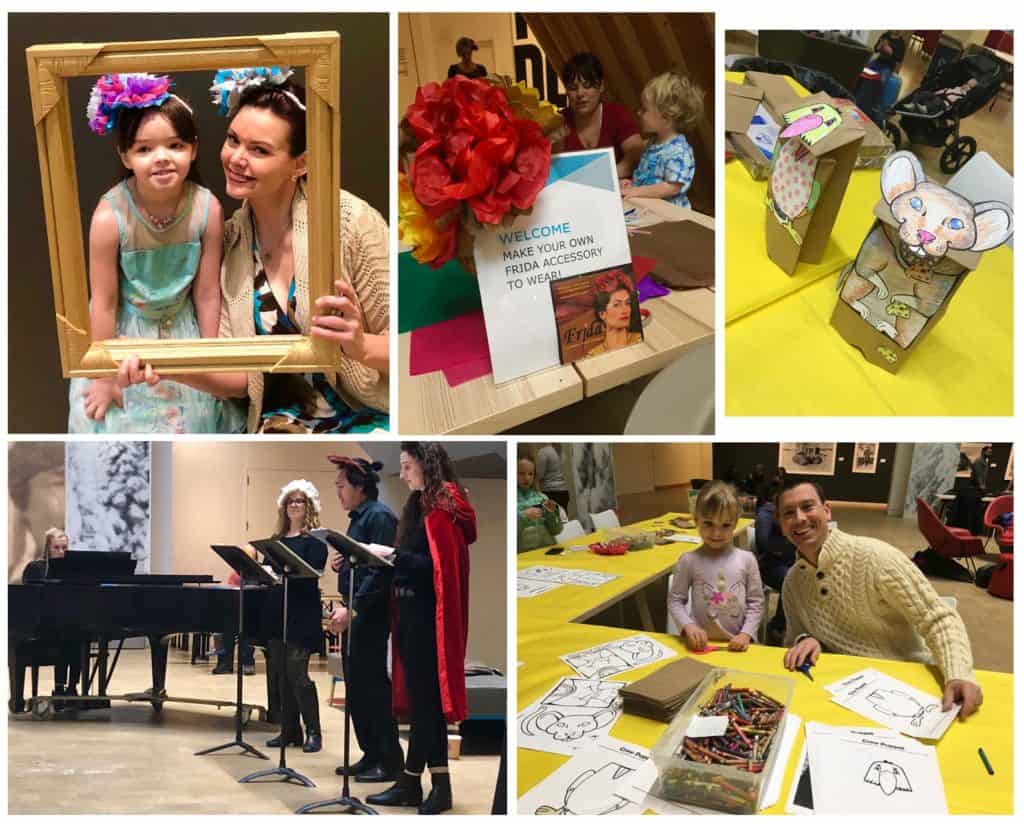
We had FUN times with some next generation opera fans at the Anchorage Museum at Rasmuson Center! We enjoyed presenting pop-up performances by our Anchorage Opera Overture Council and opera related crafts. Thank you to all the kids who brought their parents to our Family Opera Day at the Museum!


First Friday at the Anchorage Museum – February 7, 2020 (6- 8:30 pm)
The cast of Anchorage Opera’s Alaska premiere production of Frida presented pop-up performances at on Feb, 7, 2020 for the FREE & open to the public event, First Friday at the Anchorage Museum at Rasmuson Center. (Music by Robert Xavier Rodríguez, Book by Hilary Blecher, Lyrics & monologues by Migdalia Cruz) Catalina Cuervo – Frida, Bernardo Bermudez – Diego Rivera, Alejandra Martinez – Woman 1, Edmond Alexander Rodriguez – Man 1, Joanna Ceja – Woman 2, Roberto Perlas Gomez – Man 2, Stephen Karr – Conductor, Neda St Clair – Accompanist
Frida in our Schools
In the weeks before the Alaska premiere of the opera, AO took the cast and artistic team onsite to organizations engaged through the project for a program of excerpts and discussions about the production, including Anchorage School District classrooms. “One in five students comes from a household where English is not a first language and 23% of those report Spanish as their first language.” Smith said. “Opportunities to experience the arts, especially opera, are limited for ASD students. We’re proud to have reached many under-served segments of our community while simultaneously demonstrating the diversity of artists and our art form in current times, thereby making it relatable to them.”
Catalina Cuervo (Frida Kahlo), Bernardo Bermudez (Diego Rivera) and Neda St. Clair (accompanist) visited Service High School to present excerpts from the show and chatted with students about opera and life.
KTUU Channel 2 News came to Service High School and we made the news.
WATCH VIDEO>>> “Opera performers inspire a younger generation with an age-old art form” by Kristen Durand, KTUU Channel 2 News
Then we invited them to the final dress rehearsal to see the cast shine on stage. The artists and kids had a great reunion in the lobby after the rehearsal!
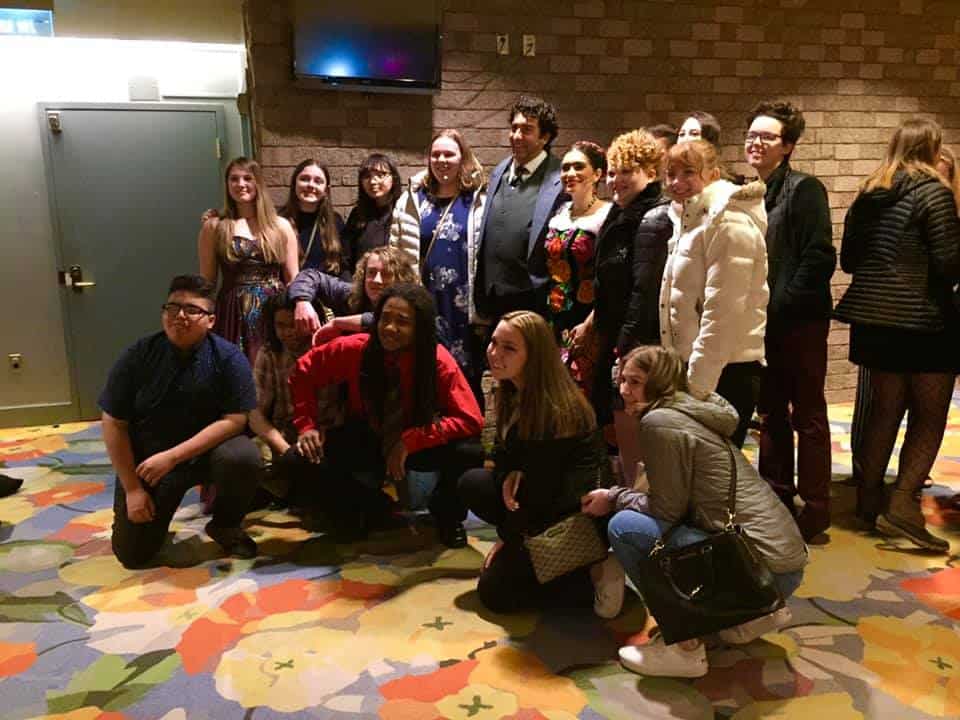
Voth Hall Exhibition
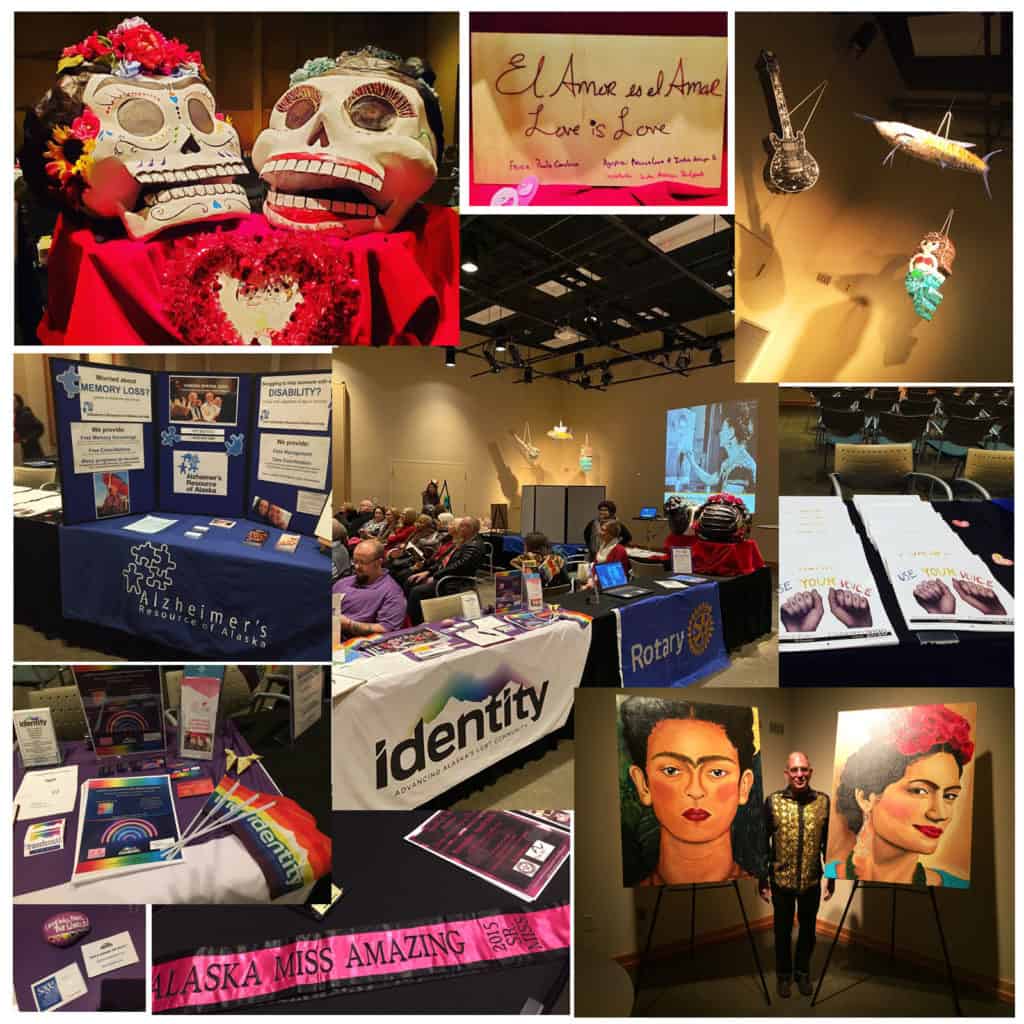
Performance Dates
Friday, Feb 14 @ 8:00 PM – Sydney Laurence Theatre in the Alaska Center for the Performing Arts
Saturday, Feb 15 @ 8:00 PM – Sydney Laurence Theatre in the Alaska Center for the Performing Arts
Sunday, Feb 16 @ 4:00 PM – Sydney Laurence Theatre in the Alaska Center for the Performing Arts
Sung in English and Spanish with English supertitles
Performance Videos
To all our friends who were unable to get a ticket to our SOLD OUT run of Frida please enjoy these montages of video excerpts and photos. To all those who did see the show we hope this brings back great memories of a great night of theater at the Alaska Center for the Performing Arts.
About
Frida
Music by Robert Xavier Rodríguez
Book by Hilary Blecher
Lyrics and monologues by Migdalia Cruz
“A telenovela set to music”

Catalina Cuervo as Frida with Michigan Opera Theatre (photo: John Grigaitis)
The life of Mexican artist Frida Kahlo is the stuff of legend. Wracked by agonizing physical pain and caught up in a stormy marriage to famed muralist, Diego Rivera, the flame that fueled Kahlo’s art kept burning bright. She painted fifty-five self-portraits, but no portrait is more revealing than the one in this opera. Robert Xavier Rodriguez’s colorful music is a pitch perfect match for the woman, her art and her passionate life. Rodríguez describes Frida as being “in the Gershwin, Sondheim, Kurt Weill tradition of dissolving the barriers and extending the common ground between opera and musical theater.” In keeping with the Mexican setting of Frida, the score features mariachi-style orchestration with authentic Mexican folk songs and dances and the composer’s own “imaginary folk music,” tangos and colorations of zarzuela, ragtime, vaudeville and 1930’s jazz — “Romantically dramatic” (The Washington Post) and full of “the composer’s all-encompassing sense of humor” (The Los Angeles Times).
Among the “stolen” musical fragments used in Frida (like Stravinsky, Rodríguez says “I never borrow; I steal.”) are such strange musical bedfellows as two traditional Mexican piñata songs (“Horo y fuego” and “Al quebrar la piñata”), two narrative ballads (“La Maguinita” and “Jesusita”), the Communist anthem (“L’Internationale”), Tchaikovsky’s Fourth Symphony, and Wagner’s Tristan and Isolde.
Rodríguez says, “You learn much more about people by watching them not alone, but in conflict with others. Frida and Diego have two powerful love scenes, one at the beginning and one at the end, with one fight after another in between. It’s that fascinating and unpredictable through-line of their relationship that drives the action.” In a musical metaphor for Frida’s unique persona, her vocal line is scored with its own characteristic rhythms. As Rodríguez observes, “Frida sings as she lived — against the tide from the very first note.”
Critics and audiences across America and throughout Europe have fallen in love with Frida…and you will too!
This Alaskan premiere of Frida is proudly presented by Anchorage Opera
Frida in Review
Named “Best Opera/Musical Theater of 1991” …a fascinating, magically engrossing evening …The music is subtle and atmospheric …genuinely original and genuinely accessible, a neat combination not that often achieved.– New York Times
“Soprano Catalina Cuervo hopes Latinos will see they can have a good time at an opera. ‘This is fun and dramatic and they will love it, they will just be on the edge of their seats,” she says. “Just like with the end of any, every telenovela.’ – NPR Weekend Edition (Veronoca Zaragovia)
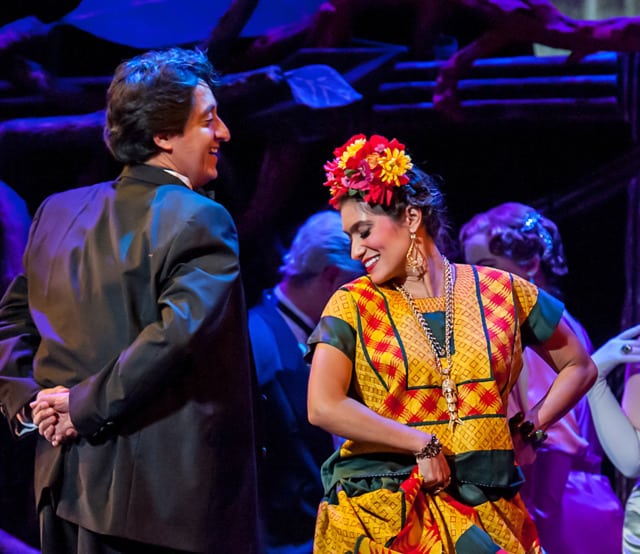
Catalina Cuervo as “Frida” with Michigan Opera Theatre (photo: John Grigaitis)
Triumphant ‘Frida’
Frida is an emotional explosion of music and color and truth that surely the artist herself would have enjoyed… We are hard-pressed to catalog the many ways Frida satisfies and surprises. At the most basic level, Kahlo’s personal story is fascinating, and there is a certain voyeuristic appeal to seeing her life played out through the dynamic amplification of modern opera. Perhaps the highest praise we can offer is that Frida faithfully represents the passion, pain, energy, defiance, vibrancy, and restless intensity that Frida Kahlo poured into her paintings. These defining emotions are reflected in the soaring music, hypnotic and eerie dancing, authentically surreal production design, and sparkling singing and acting from the ensemble…Do what you must to see this inspiring opera.” – Detroit Examiner
¡Viva la vida!
Sensational! Impacting! Magnificent! These are some of the enthusiastic words uttered by the public who attended the performance of the opera Frida last Friday at the Teatro Degollado. My mind is still full of the images and sounds of this work, which has had many successful performances in the United States and Germany since its creation in 1991. The opera is vibrant with life, expressing Frida’s motto “¡Viva la vida!” Those of us who attended were privileged to see it. And who was most responsible for this work’s impact?… The most important person here was the composer, Robert Rodríguez, who achieved a felicitous fusion of spoken dialogue, popular music and complex operatic music full of lyricism and passion…
Ovation for the Premiere of the Opera Frida
The ovation for the Spanish premiere of the opera Frida lasted for eight minutes…The sold-out audience rose and showered the stage with red and white carnations… Many audience members participated in the spectacle by coming to the theater dressed as Frida (Kahlo) and Diego (Rivera). – Franco Daniel Gómez, El Universal
Long Beach Opera presents SoCal Premiere of Opera Frida.
The opera celebrates the renowned Mexican artist Frida Kahlo, her vivacious spirit, sexuality, fragility, and her tumultuous life with muralist Diego Rivera. Robert Xavier Rodríguez’ brilliant score captures Frida with music as rich and haunting as her art. – Broadway World

Catalina Cuervo as “Frida” – Cinncinati Opera (photo: Philip Groshong)
Cincinnati Opera (Photo by Philip Groshong)
“Taking on the title role, Colombian soprano Catalina Cuervo delivered a performance that was nothing short of a tour-de-force” – Classical Voice
“As Frida Kahlo, soprano Catalina Cuervo was totally convincing, conveying Kahlo’s courage, determination, and passion at every moment.” – Opera News
“Catalina Cuervo owns the role of Frida Kahlo. A petite Hispanic woman with long raven-black hair and a substantial soprano, Cuervo was by turns imperiously self-assertive, and cawed by Rivera’s larger-than-life character. She can summon at will the demons that followed Kahlo to her grave, and then exorcise them in the arms of Rivera, a lover a decade older, all in a memorable career-defining performance.” – Seen and Heard International
Florida Grand Opera
…What sets this contemporary opera apart is not only that it is a new and acclaimed opera, (having been first performed in 1991) or that its subject matter is a biographical account of an LGBTQ icon, but rather that its colorful depiction of Mexican culture is an unapologetic celebration of diversity and inclusion, at a time when we desperately need reminding that there is much beauty and insight to be found when we educate ourselves on another’s history. Suddenly, Frida Kahlo represents so much more than a unibrow and surrealist Mexican folk art…While Frida includes more spoken text than many of the older and more traditional operas, it is Rodriguez’s evocative music that is the binding, expressively bringing the fragments of plot together, often with two or more melodies entwining in a way that creates a lovely dissonance and dramatic tension on stage… – Erin Dahlgren, Outclique Magazine
“Catalina Cuervo was a force of nature, vocally portraying the extant power inside the woman with volume that easily filled the hall, fleshing out her vulnerable side with lyric subtlety.” Miami Artzine
“Soprano Cuervo is a powerhouse…In the role of Kahlo, Cuervo gave a focused, emotional performance that avoided the diva-like, over-the-top dramatics that might have seemed obvious for such a role. Singing with smooth vocal intensity, her portrayal was characterized by strength, vulnerability and sensuality.” – South Florida Classical Review

Catalina Cuervo as “Frida” with Michigan Opera Theatre (Photo John F. Martin)
Michigan Opera Theatre
“Catalina Cuervo was ideal as Frida, a petite soprano powerhouse in a role scored for lyric mezzo. Cuervo’s exuberant voice was a soaring arrow one moment, a bright and cutting knife the next. Her titanic performance encompassed Frida’s fire alongside luxurious duets with Diego and the flirtatious sensuality of the erotic second-act quartet. Cuervo harnessed tremendous vocal strength through every inch of her range, untiring even to the final cry, “Viva la vida, alegria e Diego!” – Opera News
World renowned soprano, Catalina Cuervo, embodied the title role with the same fiery passion that Frida poured into her paintings. No stranger to the role, she garners rave reviews wherever she performs it. Hear her explain what it means to her to portray the iconic artist.
Frida Kahlo (1907-1954)
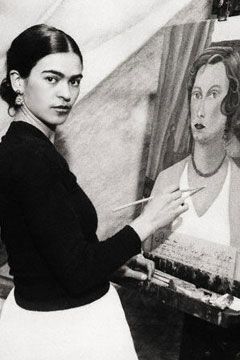
Frida Kahlo de Rivera, born Magdalena Carmen Frieda Kahlo y Calderón, was a Mexican painter known for her self-portraits. Kahlo’s life began and ended in Mexico City, in her home, which is known as “La Casa Azul,” the Blue House. Her work has been celebrated internationally as emblematic of Mexican national and indigenous traditions, and by feminists for its uncompromising depiction of the female experience and form.
Frida Kahlo began to paint in 1925, while recovering from a near-fatal bus accident that devastated her body and marked the beginning of lifelong physical ordeals. Over the next three decades, she would produce a relatively small yet consistent and arresting body of work. In meticulously executed paintings, Kahlo portrayed herself again and again, simultaneously exploring, questioning, and staging her self and identity. She also often evoked fraught episodes from her life, including her ongoing struggle with physical pain and the emotional distress caused by her turbulent relationship with celebrated painter Diego Rivera. Such personal subject matter, along with the intimate scale of her paintings, sharply contrasted with the work of her acclaimed contemporaries, the Mexican Muralists. Launched in the wake of the Mexican Revolution and backed by the government, the Mexican Muralist movement aimed to produce monumental public murals that mined the country’s national history and identity. She nonetheless participated in her peers’ exaltation of Mexico’s indigenous culture, avidly collecting Mexican popular art and often making use of its motifs and techniques. She also carefully crafted a flamboyant Mexican persona for herself, wearing colorful folk dresses and pre-Columbian jewelry, in a performative display of her identity.
Mexican culture and tradition are important in her work, which has been sometimes characterized as naïve art or folk art. Kahlo’s early recognition was prompted by French poet and founder of Surrealism André Breton, who described her art as a “ribbon around a bomb”, and enthusiastically embraced her art as self-made Surrealism, including her work in his 1940 International Exhibition of Surrealism in Mexico City. Yet if her art had an uncanny quality akin to the movement’s tenets, Kahlo resisted the association: “They thought I was a Surrealist but I wasn’t,” she said. “I never painted dreams. I painted my own reality.”
About the Composer
 Robert Xavier Rodríguez was born on June 28, 1946 in San Antonio, Texas. He studied composition with Hunter Johnson, Halsey Stevens, Jacob Druckman, and Nadia Boulanger. He gained international recognition in 1971 when awarded the Prix de Composition Musicale Prince Pierre de Monaco by Prince Rainier and Princess Grace at the Palais Princier in Monte Carlo. Other honors include the Prix Lili Boulanger, a Guggenheim Fellowship, four National Endowment for the Arts grants, and the Goddard Lieberson Award from the American Academy and Institute of Arts and Letters.
Robert Xavier Rodríguez was born on June 28, 1946 in San Antonio, Texas. He studied composition with Hunter Johnson, Halsey Stevens, Jacob Druckman, and Nadia Boulanger. He gained international recognition in 1971 when awarded the Prix de Composition Musicale Prince Pierre de Monaco by Prince Rainier and Princess Grace at the Palais Princier in Monte Carlo. Other honors include the Prix Lili Boulanger, a Guggenheim Fellowship, four National Endowment for the Arts grants, and the Goddard Lieberson Award from the American Academy and Institute of Arts and Letters.
Rodríguez’s music embraces all genres and often combines Medieval, Renaissance, and Baroque techniques with ethnic and contemporary materials. He has had particular success with his operas. His most recent, the one-act comedy La Curandera, has been produced in Colorado, California, and Texas. Frida, had acclaimed productions at the American Music Theatre Festival, The American Repertory Theatre in Boston, the Brooklyn Academy’s Next Wave Festival, Vienna Schauspielhaus, Theater Nordhausen in Germany, Mexico’s Jalisco Filharmonica, and the Houston Grand Opera. Rodríguez’s children’s opera Monkey See, Monkey Do is one of the most frequently performed contemporary operas in the US, with over 2000 performances to date. For more information about Robert Xavier Rodríguez, CLICK HERE
Cast
Production Team

Catalina Cuervo – Frida

Alejandra Martinez – Woman 1 (Cristina Kahlo [Frida’s sister], Mrs. Ford, Calaveras)

Bernardo Bermudez – Diego Rivera

Edmond Alexander Rodriguez – Man 1 (Alejandro [Frida’s 1st boyfriend], Mr. Ford, Leon Trotsky, Calaveras)

Stephen Karr – Conductor

Andreas Mitisek – Stage Director / Production Designer
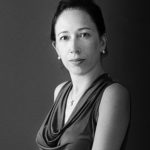
Neda St Clair – Rehearsal Accompanist

Joanna Ceja – Woman 2 (Dimas’ mother, Lupe Marin [Diego’s 1st wife] Mrs. Rockefeller, Natalia Trotsky, Calaveras)

Roberto Perlas Gomez – Man 2 (Petate Vendor, Guillermo Kahlo [Frida’s father], Mr. Rockefeller, Edward G. Robinson, Calaveras
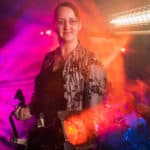
Cedar Cussins – Lighting Designer

Elle Janecek – Hair / Makeup Designer
Orchestra
Violin – Dawn Lindsay
Clarinet/Saxophone – Hayden Sterling
Trumpet/Flugelhorn – Linn Weeda
Percussion – Steven Alvarez
Accordion – Stas Venglevski
Piano – Neda St. Clair
Synopsis
Sung in both Spanish and English, Frida is the story of renowned Mexican artist Frida Kahlo, wife of the country’s great muralist Diego Riviera. Her tortured life unfolds in a flowing succession of scenes, acted and sung by two woman and two men in a variety of guises – masked or plain-faced and as two- or three-dimensional puppets; shadow puppets and projections are also involved. Diego’s preoccupation with art and other women shrivel Frida’s soul and her demands for love drain him; they need one another desperately. Divorce is imminent. Frida’s health deteriorates; only painting permits emotional release, translating her agonies into a series of canvases. Her fate is to live alone, engulfed by pain, but her paintings live forever, reflecting hidden dreams and inspiring courage to transcend conventional boundaries.
ACT I
Scene 1
Mexico City 1923. Frida at the National Preparatory School, learns what death looks like and the revolution comes to an end.
Scene 2
Frida’s Room, Coyoacan. Frida becomes a woman.
Scene 3
Mexico City in 1925. Frida and her boyfriend Alejandro board a bus. The bus crashes, Frida is severely injured, begins her life as a painter.
Scene 4
1927-1929, Frida meets and marries Diego Rivera.
Scene 5
1929-30. Diego’s work is denounced in Mexico. The Riveras resolve to try their luck in the USA.
Scene 6
New York City in 1933. Frida and Diego meet Rockefeller, who commissions the mural Man at the Crossroads.
Scene 7
New York City in 1934. Rockefeller complains about including Lenin in the mural. The mural is destroyed and Frida miscarries.
ACT II
Scene 1
San Angel, Mexico. Frida ignores the parade of women through Diego’s bedroom, but is horrified to discover her sister, Cristina, among them.
Scene 2
San Angel, Mexico 1937. Leon Trotsky and his wife join the Riveras in their house. Frida and Trotsky have a love affair.
Scene 3
Frida’s Bath. Frida retreats to the seclusion of her bath and the comfort of a female lover.
Scene 4
New York. Frida has a love affair with photographer Nicholas Murray and sells her first paintings. Frida and Diego divorce.
Scene 5
Calaveras (Mexican death figures) appear in Frida’s Imagination as she is haunted by her physical and emotional pain.
Scene 6
Finale – In delirium, Frida relives episodes of her life. Diego and Frida remarry. She departs with a cry of “Viva, la vida… allegría…and Diego.”
Free Pre-Opera Talks
One hour before each performance audience members learned about the interesting background of the work and discovered fascinating insights into the opera. Our colleague in the arts, Michael Jungreis, was our Pre-Opera Talk Host. Michael is well-known to Anchorage audiences as the host of KLEF’s “Saturday Night at the Opera”.
Friday, Feb 14 @ 7:00 pm in the Voth Hall
Saturday, Feb 15 @ 7:00 pm in the Voth Hall
Sunday, Feb 16 @ 3:00 pm in the Voth Hall

